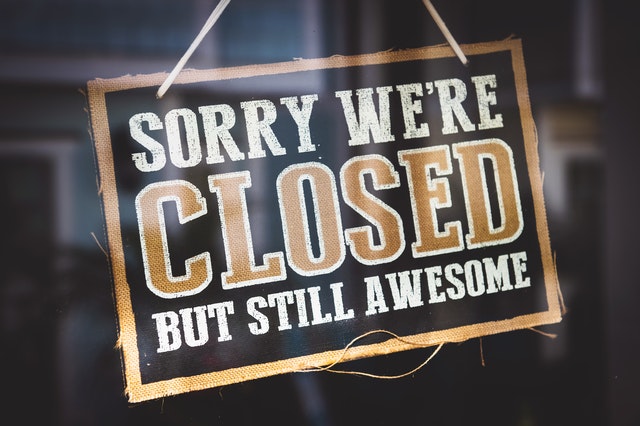No business anywhere can ever imagine when starting that one day they would be considering insolvency. For business owners that end up there it can prove bittersweet. The emotional release of all the stress and strain of running a business thats choking, as well as the pain of now actually being in this position.
The cold hard truth is that 60% of Australian businesses will fail. The reason for such failure can derive from multiple places and on many occasions isn’t a reflection of the business owner themselves. I don’t think Ive ever met a lethargic business owner whose business has failed because of them personally.
With that said, let’s talk insolvency for business owners, directors and/or shareholders.
Important Insolvency Changes Because of COVID-19
The Federal Government acknowledges that COVID-19 has pushed once health businesses into hardship. Consequently, the Federal Government passed the Coronavirus Economic Response Package Omnibus Act 2020 (the Coronavirus Response Act) and it became effective from 24 March 2020.
What is the Purpose of the Coronavirus Economic Response Package Omnibus Act 2020?
Put simply, the objective of the legislation is to assist both businesses and individuals that are experiencing cash-flow difficulties to pull through to the other side. The measures are substantial and impact not only businesses that owe money, but also those businesses who are owed money.
For a period of 6 months from 24 March 2020 (and possibly extended by the Federal Government)
- Statutory Demands cannot be issued unless the debt is at least $20,000. Prior to this legislation it was $2,000.
- Creditors cannot issue statutory demands unless the debt is at least $20,000. Prior to this was $2,000;
- Creditors cannot issue a bankruptcy notice unless the debt is at least $20,000 Prior to this it was $5,000;
- There has been an increase from 21 days to 6 months to respond to a statutory demand or a bankruptcy notice;
- Directors will not be personally liable if the relevant debts were incurred in the ordinary course of business in the 6 month period from 25 March 2020.
Whilst the new provisions are there to give business owners in financial stress a breather, creditors (those owed money) will feel the pain as well.
What the New Legislation Means for Directors
Directors are given a reprieve for a period of 6 months to do their best to try and trade their company out of insolvency without having to worry that an insolvent trading claim may show up in the mail and potentially force the business into liquidation.
That being said, Directors, of course, need to keep in the back of their minds that they:
- can be liable for claims for insolvent trading for any debts that have been incurred following the 6 month period.
- can still be liable for a myriad of other claims brought under the Corporations Act 2001
Obviously, during this time, it’s smart to get legal advice. At Law By Dan, we have a team of insolvency lawyers who can help.
What is Insolvency?
Simply put, insolvency is when a company is unable to pay its debts when they fall due for payment.
In the case of sole traders, the term that is used instead of “insolvency” is “bankrupt.” In this case, the same requirements apply, that you as a business owner becomes bankrupt when you cannot pay your debts. But because the business is related to your income as a sole trader, the debts owed are payable from your own personal assets.
In the context of insolvency, ASIC is the governing body. For sole traders it is the Australian Financial Security Authority (AFSA).
As this article deals with insolvency, if you’re a sole trader, there is good information here.
What are the Procedures of Becoming Insolvent?
The most common corporate insolvency procedures are:
- voluntary administration
- liquidation and
- receivership.
What is Voluntary Administration?
Basically voluntary administration is all about providing a company with some breathing room from the rigours of running the business. The process involves the company directors appointing an administrator who will attempt to put the business back on track.
In contrast to liquidation which is all about winding the business up, the objective of a voluntary administration is to save the company so it can continue to trade and obviously meet its debts.
The Benefits of Voluntary Administration
This approach is preferable if the objective of the directors is to get the company to trade out of its financial distress. It restrains creditors from enforcing their claims, giving the business some runway to pull its way out of trouble.
More specifically, voluntary administration provides directors with assurances that:
- The company cannot be wound up;
- Securities cannot be enforced (with some exceptions);
- An owner or lessor cannot recover property used by the company (with some exceptions);
- Legal proceedings cannot be commenced against the company (with some exceptions);
- A company director’s guarantee cannot be enforced.
How Does a Company Start the Process of Voluntary Administration?
There are a number of ways that the process can begin:
Section 436A of the Corporations Act 2001 , allows directors to appoint a voluntary administrator in the event that the board (made up by the directors) resolves in writing that the company can no longer meet its debts and consequently is insolvent or likely to become insolvent.
What Duties Has the Administrator?
The voluntary administrator has multiple duties including:
• taking control of the company’s assets
• investigating all the company’s affairs
• reporting any potential offences to Australian Securities and Investments Commission (ASIC)
• assisting the directors to formulate a DOCA proposal
• reporting to creditors on the course of action that gives the best results for creditors
• calling the required meetings of creditors to decide the company’s future.
What is Liquidation?
Sometimes calling “winding-up,” liquidation is the process of finalising a company’s affairs. Liquidation is primarily focussed on the distribution of funds from the company to its creditors, followed by the shareholders.
In the context of liquidation, there are a number of ways it can be executed. It can be wound-up by the court or voluntarily by resolution of the company directors. The former requires that the applicant demonstrates to the court that the company is, in fact, insolvent or can be deemed to be insolvent. What usually follows is that the court will appoint a liquidator, more times than not, one appointed by the creditor. In cases where a company is embroiled in irreconcilable disputes between shareholders or directors, it may also appoint a liquidator.
Voluntary administration is exactly what it says it it is. The company voluntarily appoints a liquidator, though creditors do have the option of changing the appointed liquidator. In this case, creditors will need to make a request to the appointed liquidator to call a meeting of creditors to consider a resolution for their replacement.
In this circumstance they will need:
- A Consent to Act, and
- A Declaration of Independence, Relevant Relationships and Indemnities (DIRRI) from an alternative Liquidator.
What is Receivership?
Receivership is most times initiated by a secured creditor, more times than not, it’s a bank that holds security over the company’s assets. The receiver’s primary focus is to collect and sell the relevant (charged) assets so it can repay what’s owed to the secured creditor, followed by, other creditors as required by legislation.
The difference between receivership and administration is that the former allows the company to continue to exist with the directors in place, albeit with limited roles. Also, receivership does not signal that the business is all over. It may in fact recover and go onto become a successful business.
What is a Deed of Company Arrangement (DOCA)?
When a company goes into voluntary administration, it’s required that a binding arrangement is initiated between the company and its creditors. This binding arrangement is known as a Deed of Company Arrangement (DOCA).
Who Gets Paid the Money First?
When it comes to distributing funds to creditors, the term “preferences” is used to describe those payments or transfers of assets that give a creditor an an advantage over other creditors.
Preferential Payments are defined in section 588FA(1) of the Act as an unfair preference payment given by a company to a creditor of that company if, and only if:
- the company and the creditor are parties to the transaction (even if someone else is also a party); and
- the transaction results in the creditor receiving from the company, in respect of an unsecured debt that the company owes the creditor, more than the creditor would receive from the company with respect to the debt than if the transaction were set aside and the creditor was to prove for the debt in the winding up.
Put simply, a preferential payment is basically when an insolvent company makes payments to unsecured creditors over secured creditors without a sound reason to do so. In this circumstance, those payments can be deemed void.
In contrast, the role of a liquidator’s is to distribute the company’s assets between its creditors on an equal basis (pari passu).
What To Do If Your Company is at Risk of Insolvency
If your company is experiencing financial difficulty, getting prompt legal advice from an insolvency expert is recommended. In this case, your insolvency lawyer will liaise with other professionals like accountants if required. Many companies that eventually fold do so because the directors failed to act quickly enough to turn things around.
Some of the signs of a business heading towards insolvency include:
- the recording of ongoing losses
- lumpy or poor cash flow
- an increase in debt with liabilities outweighing assets
- long delays in moving stock
- difficulty recovering debts
- inability to pay outstanding tax debts
- creditors unpaid outside usual terms
- correspondence from lawyers with letters, demands, summonses, judgements or warrants issued against your company




